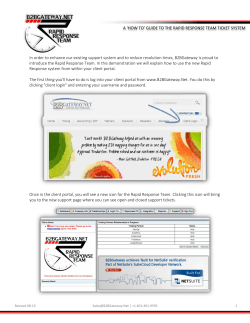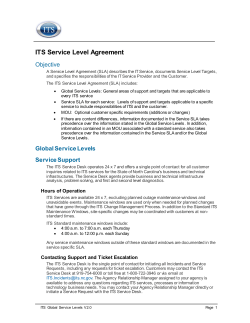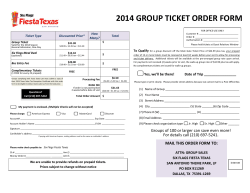
ServiceNow ServiceNow “How-To” FAQs
ServiceNow ServiceNow “How-To” FAQs 1. What if the contact is not a UBC Student, Faculty or Staff member? If you cannot find the contact you are looking for, you must select “Guest User” from the lookup list, and then enter the actual contact details in the “Description” box. For best practice, also enter the name in the Short description; this will help you to look up users when more than one guest user is assigned to you. 2. The location I am looking for is not listed (in the “Location of Issue (Building)” field). Why can’t I find it and what should I do now? The location information is provided by Archibus - the UBC facilities database. Although the Archibus list is extensive, there will be some locations which aren’t listed, for example, buildings under construction, temporary portable offices etc. In these instances, if necessary, the location detail can be noted in the Description section. 3. How long, after a period of inactivity, does ServiceNow time-out? ServiceNow will time-out after 1 hour (60 minutes) of inactivity. 4. What is a Watch List? The Watch List allows individuals to monitor the progress of specific incidents by specifying the email addresses of those wishing to be notified of any progress/updates made. Watch List users will receive all Additional Comments that are added to the ticket. Watch List users, however, will not receive notifications when the agent emails the customer through Service Now. The Watch List should be used for internal use. 5. I noticed that there is a Watch List and an ITIL Watch List, what is the difference? ITIL Watch List users receive the same notifications as Watch List users, but will also receive a notification when a Work Note is added to the incident. 6. How do I add more than one contact to the Watch List? Select the padlock icon which will bring up a text box then enter either an email address or search for a name. 7. What is the difference between the “Description” box and the “Work Notes” box? The “Description” box should be used to record all incident details and symptoms. The “Work Notes” box should be used to record all trouble shooting steps and information. 8. Do I need to log everything? It is best practice is to log everything; however, common sense should prevail. 9. What is the process for prioritizing incidents? All incidents are classified in accordance with the global priority matrix. All high / critical calls are escalated as per matrix best practices. Please refer to the global priority matrix quick reference card here. 10. At which points does ServiceNow generate automatic emails to clients? Clients will receive an email when a new incident/service request is created on ServiceNow and when the status is changed to “resolved”. 1 11. Is there a flag if a ticket hasn’t been worked on for a while? No. In this current module there is no flag. This can only be determined by running a manual report. 12. What if a ticket contains more than one incident or request that needs to be transferred to different groups? In this instance, new tickets will have to be created for each service request or incident as a ticket can only be transferred to one group at a time. 13. Does service now contain SLA functionality? Not yet, however this may be incorporated in future releases/modules 14. What kind of tickets will be logged in ServiceNow? You will use ServiceNow for logging incidents and service lite requests however future release will include a request fulfillment module provide more functionality. 15. What do we do with open tickets incidents or service lite request on our current systems (SDE/JIRA)? After four weeks, these will need to be manually moved onto SNC. 16. Does everybody have the same access privileges in Service now? No. A user can be assigned one of four roles in ServiceNow: User: The user/process role can perform standard actions for an IT service desk technician Administrator (Admin): The IT administrator has more privileges than the role and is intended for Team Leads Reporter: user capabilities plus ability to run reports. Director: reporter capabilities but receives no notifications and tickets cannot be assigned to this person 17. Will our webforms transition to ServiceNow? All webforms which have been identified by the project team and group managers will be directed to Service Now on go live day. Check with your manager to find out more. 18. Who is the owner and/or ultimately responsible for the incident/service request? Incidents and Requests are stewarded to completion by the assigned analyst or group i.e. once an agent receives a ticket, they will oversee that ticket until it is assigned to another person/group. The end user relationship is owned by the original agent who logged the record in the first place. This person is responsible for ensuring the incident or request was resolved/fulfilled to the customer's satisfaction before closing the ticket. 19. Is “short description” searchable by report? No. 20. Does ServiceNow contain student data? 21. Yes 22. Will we be required to collect department data for Students? No, at this time there is no requirement to collect department data for students; although the pop up window will appear when the department field is blank, this value is a required field for staff and faculty (i.e. UBC Role=EMPLOYEE) only. 2 23. Does the customer receive any automatic notifications? Yes. The customer will receive notification when the ticket is in the opened and resolved state. 24. At what point does a ticket close automatically? A ticket will close automatically 3 days after it is marked as resolved 25. Will there be an audit trail of the ticket activity? Yes. Each time you make an update and save, this will be recorded in the activity section –the activity section is noneditable. 26. I notice there is an “Apply Template” function; I would like to create a new template. Who has access to create these templates? Templates can be created by the ITIL admin role – this would normally be your manager/team lead. 27. What is the purpose of the “Type” field? The type field indicates which category the ticket falls into i.e. Incident, Request, Password, How-To and Information Request. Incident: An unplanned interruption (outage or performance reduction) to normal service operation Request: A request to access a service (Service Request) Information Request: A general inquiry for information How To Request: A specific question about how to… Password Reset: A request to reset a password It is important this field is completed accurately to ensure it is correctly categorized. Please note, by default, the value of this field is incident. 28. Does ServiceNow have an auto save function? No, however, if you have made changes and haven’t saved yet, the system will prompt you when you try to navigate to a different page. 29. Why can’t I use my CWL password to log in to ServiceNow? While your ServiceNow user name can be the same as your CWL user name, the two accounts are not connected. Therefore, a change made to your CWL password will not affect your ServiceNow login, and vice-versa. However, the ServiceNow login will switch to Shibboleth (CWL authentication) in the fall. 30. When I make changes to “My Homepage”, I see two homepage options: “My Homepage” and “My My Homepage”. How can I change this? “My Homepage” is a default view. When you make changes to the layout, ServiceNow saves it as “My My Homepage.” You can edit this name by clicking in the title bar, and typing a name that makes sense to you, such as “Sam’s Page”. You will now see that you have two view options: “My Homepage” (the default view) and “Sam’s Page” (your custom view). 31. How do I print so I can see ALL the ticket details? The Print Friendly version seems to miss out some detail. The best way to print a ticket is to convert it into PDF. If you right-click on the incident’s menu bar, select Export, and then PDF, this will convert the ticket into PDF. From that PDF you can see the Description (and initial email contact) and any Work Notes and comments that belong to that incident (at the time the PDF was created. 3 32. What is the difference between “comments” and “work notes” in an incident form? Comments are visible to your customer, whereas work notes are visible to other IT support staff. When you update comments or work notes, any people listed on the watchlist and ITIL watchlist respectively will be notified by ServiceNow and be able to read what you have written. 33. Where can I find more information about ITSM, the ITSM process frameworks and the ServiceNow functions that I need to use in my job? You can refer to the ITSM website, which includes information about ITSM, links to the ITSM process frameworks and the ServiceNow UBC Process User Guide. 4
© Copyright 2025





















